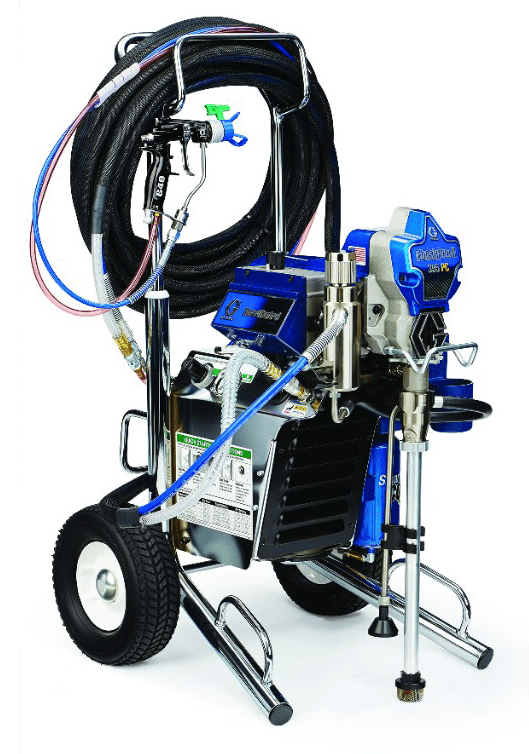What is air assisted airless sprayer?
 An air-assisted airless sprayer combines the high output of airless spraying with the added control of air spraying, resulting in a smoother and more consistent finish. Its “soft” spray atomization
An air-assisted airless sprayer combines the high output of airless spraying with the added control of air spraying, resulting in a smoother and more consistent finish. Its “soft” spray atomization
These sprayers introduce a small amount of air into the spray stream to help atomize the paint, making it finer and more controlled. This results in a smoother, more consistent finish and reduces overspray compared to traditional airless sprayers. They are often used in applications where a high-quality finish is required, such as in the finishing work of furniture, cabinets, or millwork.
Table of Contents
Where are they used?
This kind of sprayer system is utilized in the application of heavy-duty marine, chemical, and industrial linings and coatings.
It boasts several benefits, including enhanced penetration of the coating into small crevices and pits, a uniform coating that requires fewer applications, and a wet coating that ensures optimal flow and adhesion.
Some common industries and applications include:
Woodworking – For the finishing of furniture, cabinets, and millwork
Automotive – For the painting of cars, trucks, and other vehicles
Industrial painting – For the application of protective coatings on pipelines, tanks, and other industrial equipment
Marine – For the painting and protection of boats, ships, and other marine structures
Chemical – For the protection and preservation of chemical processing equipment
Architectural – For the painting of buildings and structures
General contracting – For the application of paint and coatings in construction projects
Types of paints that can be used in an air-assisted airless sprayer

- Latex paints
- Oil-based paints
- Enamels
- Stains
- Primers
- Industrial coatings
Difference between air-assisted airless, airless, and air sprayers
The air-assisted airless paint sprayer differs from the Airless sprayer and the Air sprayer. Let’s discuss them one-to-one basis.
The main difference between an air-assisted airless and an air sprayer is how the paint is atomized.
As mentioned above, an air-assisted airless paint sprayer uses a combination of high pressure and a small amount of air to atomize the paint. This breaks up the paint into smaller droplets, resulting in a smoother, more consistent spray pattern and reducing the amount of overspray, producing a high-quality finish – a good choice for spraying materials that are difficult to atomize using just high pressure.
On the other hand, with an air sprayer, high-pressure air is used to atomize the paint and create a mist, which is then directed onto the surface to be coated. This results in a very fine, delicate mist that can be easily controlled for precise application.
In an airless sprayer, high pressure is used to force the paint out of the spray tip, breaking it into small droplets as it exits the tip. This results in a coarser spray pattern with larger droplets and a higher degree of overspray.
How did the technology of air-assisted airless sprayers come about?
The technology evolved as a solution to the limitations of traditional airless paint sprayers and air paint sprayers.
Airless sprayers were first introduced in the early 1900s and quickly became popular for their ability to spray thicker materials at high speed, making them ideal for large surface area coverage. However, traditional airless sprayers had a number of drawbacks, including high levels of overspray and a coarser, less consistent finish.
On the other hand, air sprayers offered more control and a finer, smoother finish. Still, they were limited by the amount of material they could atomize and the amount of air required to do so, resulting in slower coverage and a greater demand for compressed air.
To overcome these limitations, engineers and technicians began experimenting with ways to combine the best features of both types of sprayers. The result of this experimentation was the development of the air-assisted airless sprayer. By introducing a small amount of air into the spray stream of an airless sprayer, they were able to produce a smoother, more consistent finish with less overspray.
The technology has continued to evolve, with advances in spray tip design, control systems, and material delivery systems, allowing air-assisted airless sprayers to become versatile and widely used tools in a variety of industries, including woodworking, automotive, and industrial painting.
Pros and cons
Pros:
Fine Finish – They produce a finer, smoother finish than traditional airless sprayers, making them a good choice for applications requiring a high-quality finish.
Reduced Overspray – The addition of air helps to break up the paint into smaller droplets, resulting in a smoother, more consistent spray pattern and reducing the amount of overspray.
Increased Transfer Efficiency – The increased atomization and reduced overspray result in higher transfer efficiency, meaning that more of the paint ends up on the surface being coated, and less is wasted.
Versatility – They can be used to spray a wide range of materials, from thin to thick viscosities, making them a versatile choice for many applications.
Cons:
Slower Coverage – They are slower than traditional airless sprayers, making them less efficient for large surface area coverage.
Increased Cost – They are typically more expensive than traditional airless sprayers due to the added complexity of the air atomization system.
Need for Compressed Air – They require a source of compressed air, which can add to the cost and complexity of using these sprayers.
Increased Maintenance – The added components of the sprayer, such as the air atomization system, can result in increased maintenance requirements and the need for more frequent servicing.
Conclusion
Air-assisted airless sprayers are a popular choice in a variety of industries where a high-quality finish is required. They offer several advantages over traditional airless sprayers, including a finer finish, reduced overspray, increased transfer efficiency, and versatility. However, they also have some disadvantages, including slower coverage, increased cost, the need for compressed air, and increased maintenance requirements.

